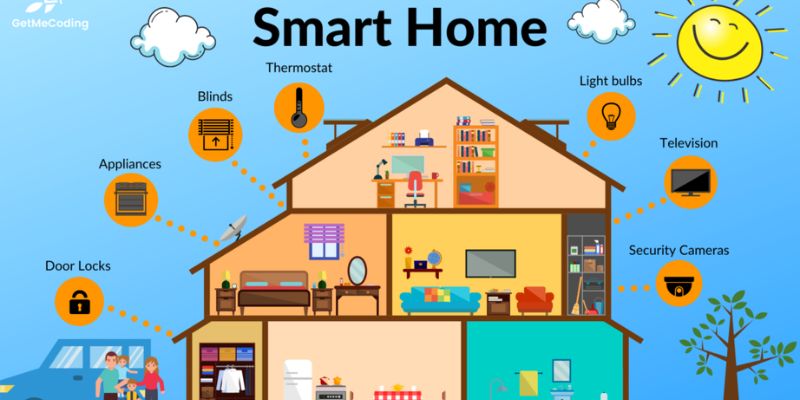As smart home technology continues to evolve, more and more homeowners are embracing the convenience and connectivity it offers. From controlling lights and appliances with a simple voice command to monitoring security cameras from anywhere in the world, smart homes have become an integral part of modern living. However, with these advancements come concerns about privacy and security. In this article, we will delve into the topic of “How Do I Ensure the Security of My Smart Home in 2023?” and provide you with expert tips and best practices to ensure the safety of your connected devices and personal data.
How Do I Ensure the Security of My Smart Home in 2023?
- Keep your devices up to date with the latest firmware and security patches.
- Change default usernames and passwords for all your smart home devices.
- Secure your home Wi-Fi network with a strong, unique password.
- Enable two-factor authentication whenever possible.
- Regularly review the privacy settings and permissions granted to your smart home apps.
- Be cautious while granting access to third-party apps and services.
- Create separate user accounts for each member of your household.
- Disable unnecessary features or services that you do not use.
- Regularly monitor and review your smart home device logs for any suspicious activities.
- Invest in a reliable and reputable smart home security system.
- Educate yourself and your family members about potential security risks and best practices.
-
Protecting Your Smart Home Network
Your home network serves as the backbone of your smart home ecosystem. It is crucial to take steps to secure it from potential threats. Here are some key measures you can implement:
Segment Your Network
By creating separate network segments for your smart home devices and your regular internet usage, you can mitigate the risks of unauthorized access. This ensures that even if one device is compromised, it won’t compromise the entire network.
Set Up a Guest Network
When hosting guests, it’s common to share your Wi-Fi password. However, by setting up a guest network, you can provide internet access without exposing your primary network to potential vulnerabilities.
Use a Strong, Unique Password
Your Wi-Fi network password should be a combination of upper and lower case letters, numbers, and special characters. Avoid using easily guessable passwords like “123456” or “password.”
Implement Network-level Security Measures
Consider implementing network-level security measures such as a firewall and intrusion detection system (IDS) to monitor and protect your network from unauthorized access attempts.
Regularly Update Router Firmware
Keep your router’s firmware up to date by installing the latest patches and updates provided by the manufacturer. This ensures that any known vulnerabilities are patched, reducing the risk of exploitation.
-
Securing Your Smart Home Devices
Your smart home devices are the endpoints through which you interact with your connected home. Securing them is paramount to maintaining the overall security of your smart home ecosystem. Consider the following steps:
Change Default Credentials
When setting up a new smart home device, it often comes with default usernames and passwords. Hackers can easily exploit these defaults. Make sure to change these credentials immediately to unique and strong ones.
Enable Two-Factor Authentication (2FA)
Two-factor authentication adds an extra layer of security by requiring an additional verification step, such as a code sent to your smartphone, to access your smart home devices. Enable 2FA whenever possible to enhance security.
Regularly Update Device Firmware
Manufacturers frequently release firmware updates that address security vulnerabilities and enhance device performance. Keep a close eye on these updates and promptly install them to ensure your devices are protected.
Review App Permissions
Smart home apps often request various permissions to access device features and data. Periodically review and revoke unnecessary permissions to limit potential exposure of your personal information.
Audit Connected Devices
Regularly audit the devices connected to your smart home ecosystem. Remove any devices that are no longer in use or that you do not recognize. This reduces the attack surface and potential vulnerabilities.
-
Safeguarding Your Smart Home Data
Protecting your personal data is essential in the age of smart homes. Here are some steps you can take to safeguard your sensitive information:
Encrypt Your Data
Enable encryption for your smart home devices and data. Encryption converts your information into unreadable code, ensuring that even if it’s intercepted, it remains secure.
Secure Cloud Storage
If your smart home devices utilize cloud storage for data backups or remote access, ensure the cloud storage service provider offers robust security measures, such as end-to-end encryption and multi-factor authentication.
Regularly Backup Data
Regularly back up your smart home device settings, configurations, and data. In the event of a security breach or device failure, you can quickly restore your settings and data without significant loss.
Monitor Data Sharing Practices
Review the data sharing practices of your smart home device manufacturers and service providers. Ensure they have robust privacy policies and do not sell or share your personal information without your consent.
Protect Your Privacy
Cover or disable cameras and microphones when they are not in use. It is crucial to maintain your privacy within your smart home environment.
FAQs:
-
How do I choose a reliable smart home security system?
When selecting a smart home security system, consider the following factors:
- Research the reputation and customer reviews of different security system providers.
- Look for systems that offer encryption and secure communication protocols.
- Ensure the system integrates with your existing smart home devices.
- Consider professional monitoring options for added security and peace of mind.
-
Are smart home devices prone to hacking?
While no system is entirely hack-proof, implementing robust security measures significantly reduces the risk of hacking. By following best practices like updating firmware, using strong passwords, and regularly monitoring your devices, you can enhance the security of your smart home.
-
Can smart home devices be used to spy on me?
Smart home devices with cameras and microphones have the potential to be exploited for unauthorized surveillance. To mitigate this risk, carefully review the privacy settings and permissions granted to each device, and cover or disable cameras and microphones when not in use.
-
Should I trust third-party apps and services with my smart home data?
Before granting access to third-party apps and services, carefully review their privacy policies, terms of service, and user reviews. Only choose reputable apps and services that have strong security measures in place.
-
Can I control the security of my smart home remotely?
Yes, many smart home systems offer remote access capabilities. However, ensure you secure your remote access with strong passwords and enable two-factor authentication to prevent unauthorized access.
-
How often should I update my smart home devices?
Regularly check for firmware updates provided by the manufacturers of your smart home devices. It is recommended to update your devices as soon as updates become available to ensure you have the latest security patches.
Conclusion: Ensuring a Secure Future for Your Smart Home
As the adoption of smart home technology continues to rise, so does the importance of securing these devices. By implementing the expert tips and best practices outlined in this article, you can significantly enhance the security of your smart home in 2023 and beyond.
Remember to stay vigilant, educate yourself about the latest security threats, and regularly review and update your security measures. With the right precautions in place, you can enjoy the benefits of a connected home while keeping your personal data and privacy safe.


how to get cenforce without a prescription – purchase cenforce online order cenforce without prescription